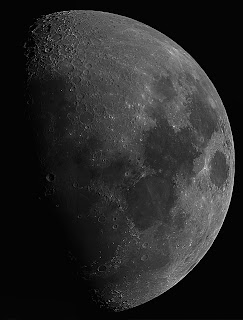M33 Triangulum Galaxy
I have been itching to get out and collect more data but February has been a rough month so far. It seems winter has just turned on full blast and hasn't given us any clear dark nights. I could see some stars in the sky tonight but there is too much moisture in the sky to get any decent signal. Not to mention it is freezing cold. Who is ready for spring?! I have been working on my galaxy technique to get more detail and contrast out of my galaxy pictures. This is my third take on M33 with the same data. I extracted a luminance frame from my background corrected linear image. Then I made a combined range and star mask to protect the stars and background while sharpening the signal. I used deconvolution with an average PSF star sample with about 50 iterations. This gives me a nice sharpened luminance frame that I combine with the original image. I then do a mask to protect the signal and stars and decrease the noise in the background. Now I transform my linear images to non-linear using the histogram stretch. Next I use my combined mask on the color image and do a HDR transformation to bring out some of the hidden detail in the bright or overexposed areas. Then I combined the luminance frame with the color frame. I will then increase the color saturation, adjust the luminance, and signal with the curve transformation tool. The last thing I do is a local histogram equalization to help bring out more contrast in the fine detail. Three times is a charm.
You can easily see some of the H-II regions in the dark lanes of the arms. A lot of pictures that you see of this galaxy in my opinion are over done in color saturation in the blue region. There are blue star clusters in this galaxy but they aren't the dark blue near purple clusters you see in other pictures. This image is a true representation of color. One thing I would like to try next year is to get some H-Alpha data and combine it to bring out the H-II areas. Hopefully we will get some good clear dark skies in a week or two.
You can easily see some of the H-II regions in the dark lanes of the arms. A lot of pictures that you see of this galaxy in my opinion are over done in color saturation in the blue region. There are blue star clusters in this galaxy but they aren't the dark blue near purple clusters you see in other pictures. This image is a true representation of color. One thing I would like to try next year is to get some H-Alpha data and combine it to bring out the H-II areas. Hopefully we will get some good clear dark skies in a week or two.



Comments
Post a Comment